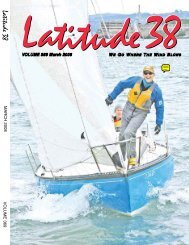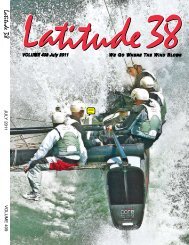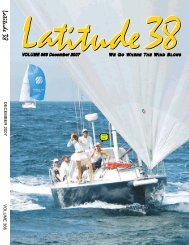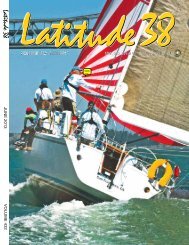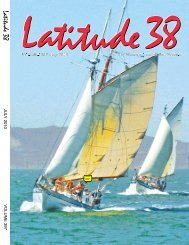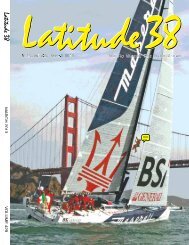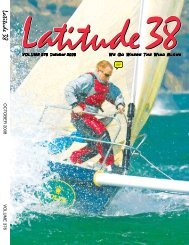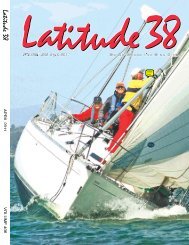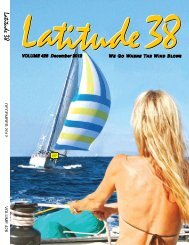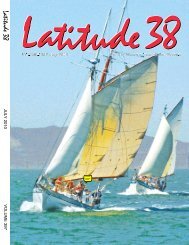October 2009 eBook all pages (free PDF, 36.6 - Latitude 38
October 2009 eBook all pages (free PDF, 36.6 - Latitude 38
October 2009 eBook all pages (free PDF, 36.6 - Latitude 38
Create successful ePaper yourself
Turn your PDF publications into a flip-book with our unique Google optimized e-Paper software.
MAX EBB<br />
"Fin<strong>all</strong>y!" our skipper cheered<br />
before the echoes of the gun had faded.<br />
"Postponement over! Let's get this race<br />
going!"<br />
We'd been waiting two hours for the<br />
wind to stabilize. It had never been flat<br />
calm, but it was not the steady sea breeze<br />
the Race Committee wanted. Evidently<br />
they thought it was worth the wait.<br />
All hands on our boat felt otherwise.<br />
They were from Southern California, in<br />
town for a major regatta, and I'd been<br />
recruited as a source of local knowledge.<br />
Fortunately, I was able to bring Lee Helm<br />
along with me. She's a naval architecture<br />
grad student at the university, and<br />
although I have a few more decades'<br />
experience racing on the Bay than she<br />
does, Lee seems to be able to make more<br />
sense out of the instruments, the polars<br />
and her custom tide charts. As long as<br />
she can pass me secret tips during the<br />
race, I can fake it pretty well.<br />
"Wait a sec," said Lee, examining<br />
the RC boat through binoculars. "They've<br />
got the gun up for another shot."<br />
The end of a postponement is signaled<br />
by one gun, and a postponement is signaled<br />
by two. When the second gun fired,<br />
we couldn't understand why they would<br />
postpone a race that was already postponed.<br />
Then there was a third gun.<br />
"Code flags N over A," Lee sighed. "All<br />
races abandoned for the day."<br />
"Darn," muttered the skipper. "I<br />
thought we'd fin<strong>all</strong>y have a chance to<br />
see what we could do against this fleet<br />
in light air."<br />
"Clearly a decision driven by bar<br />
revenue," said the owner, who doesn't<br />
drive or even trim sails during the races,<br />
but loves to organize the campaign and<br />
write the checks. "The bar makes more<br />
money for the club if they get us back to<br />
the harbor early."<br />
"Either that or<br />
someone on the<br />
RC boat has opera<br />
tickets," groused<br />
a n o t h e r c r e w .<br />
"You'd think, what<br />
with having a whole<br />
navy out here to set<br />
marks and signal<br />
courses, they could<br />
at least give us a<br />
short course in the<br />
wind we've had <strong>all</strong> morning instead of<br />
making us wait around for the seabreeze<br />
that we <strong>all</strong> know will fill in as soon as<br />
we're back at the dock."<br />
"Down south we race in wind lighter<br />
than this <strong>all</strong> the time," said the owner.<br />
Page 124 • <strong>Latitude</strong> <strong>38</strong> • <strong>October</strong>, <strong>2009</strong><br />
The formula for Sample Standard Deviation. T is<br />
corrected time and n is the number of finishers<br />
in the division.<br />
"We could have spent the last two hours<br />
racing."<br />
"Yeah, since when is an RC so afraid<br />
of a wind shift that they have to cancel<br />
a whole day of sailing?" asked another<br />
crew. "I started racing on Long Island<br />
Sound, and back there we'd c<strong>all</strong> this a<br />
good stiff sailing breeze."<br />
"Before you <strong>all</strong> go off half-cocked on<br />
this," said the mainsail trimmer, trying<br />
to calm us down, "consider that one of<br />
the purposes of the regatta is to come<br />
up with an over<strong>all</strong> winner. And because<br />
they have the different divisions sailing<br />
different courses and starting at different<br />
times, their method of selecting the<br />
over<strong>all</strong> winner only works if the wind is<br />
steady."<br />
"Well, we're sure not in it for the<br />
over<strong>all</strong> win," the owner reminded us as<br />
he stepped from the back of the cockpit<br />
to the top of the companionway ladder.<br />
"We just want to race. We came <strong>all</strong> the<br />
way up from SoCal, and they've wasted<br />
a perfectly good day of sailing. I'm going<br />
below to break out lunch. Who had the<br />
one with no mayo?"<br />
"No tomatoes on mine," said Lee.<br />
'"They're <strong>all</strong> no tomatoes," the owner<br />
c<strong>all</strong>ed back from the cabin. "Keeps the<br />
bread from getting soggy."<br />
"But how can they possibly have an<br />
over<strong>all</strong> winner if the divisions are sailing<br />
different courses?" I asked.<br />
"It's, like, in the sailing instructions,<br />
under scoring," said Lee. "What they do<br />
is take the corrected time of the winner<br />
of each division, divide by the course<br />
distance to get the corrected speed, and<br />
see who is sailing the fastest, averaged<br />
over <strong>all</strong> the races sailed."<br />
"Sounds fair enough, if the conditions<br />
are steady."<br />
"Except for one big thing they got<br />
wrong," Lee noted.<br />
"The finish is upwind<br />
of the start,<br />
and the big boats<br />
u s u a l l y s a i l a<br />
course with more<br />
laps than the sm<strong>all</strong><br />
boats. Especi<strong>all</strong>y<br />
for a series sailed<br />
in mostly flood tide,<br />
that makes a diff."<br />
"How big?"<br />
"Okay, we can<br />
tot<strong>all</strong>y figure it out. "If the course is W-<br />
L-W-L-W — or two-and-a-half sausages<br />
— for the big class, that's three upwind<br />
and two downwind legs." She produced a<br />
sm<strong>all</strong> cell phone in a plastic bag from her<br />
PFD pocket and switched it into calcula-<br />
tor mode. "Let's say they go seven knots<br />
upwind and tack through 70 degrees.<br />
That's a VMG of 5.7 knots, subtract a<br />
knot for flood current and VMG upwind<br />
is 4.7. Downwind, let's be conservative<br />
and say 8.5 knots VMG plus the current,<br />
for 9.5 knots down the course. Average<br />
speed for the five legs is then . . . 6.62<br />
knots. But if they sail the shorter course,<br />
just one-and-a-half times around, they<br />
get a higher ratio of windward to leeward<br />
because of the upwind finish. Then the<br />
average speed around the course is . . .<br />
6.3 knots.<br />
"Pretty close, if you ask me," I ventured.<br />
"No way! That's, like, a five percent<br />
rating advantage. Ginormous compared<br />
to typical finish margins in a top-end<br />
fleet."<br />
"What about when the course is threeand-a-half<br />
laps versus two-and-a-half?"



